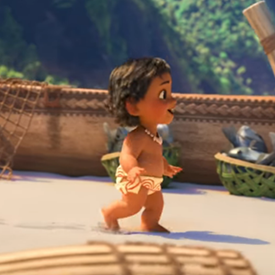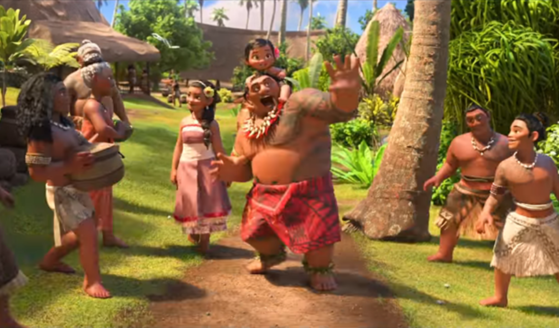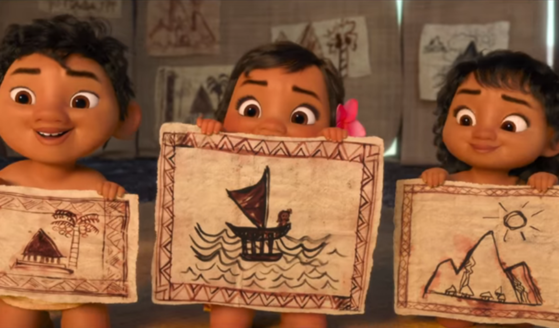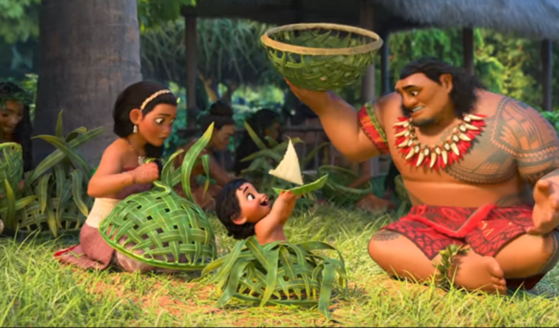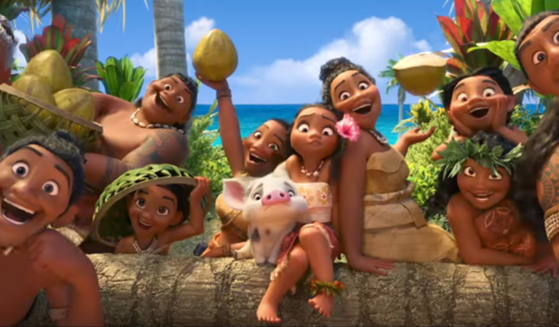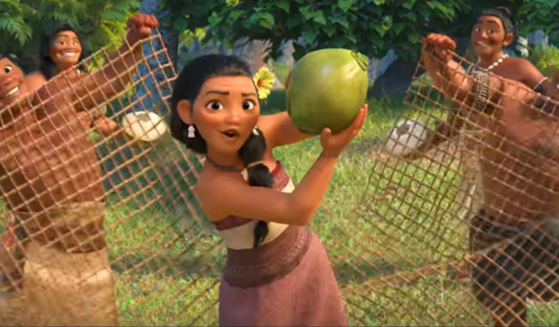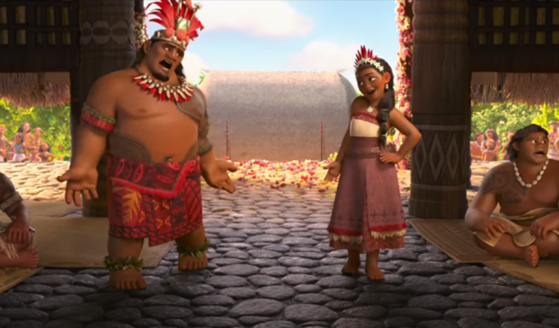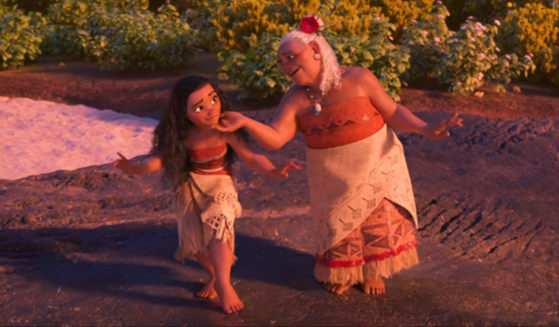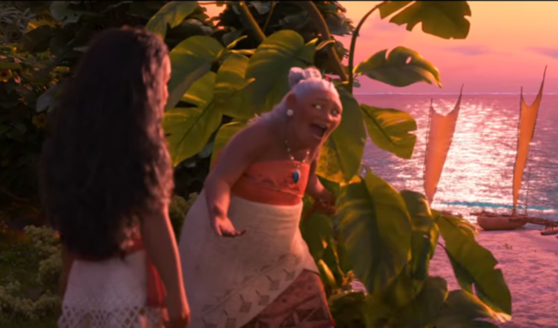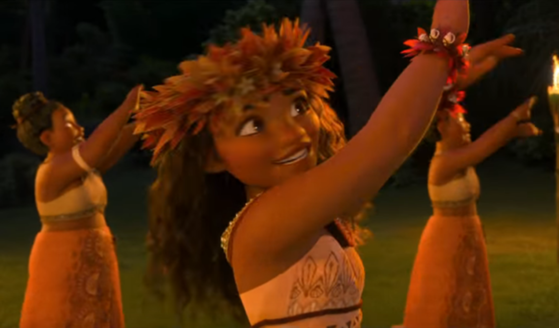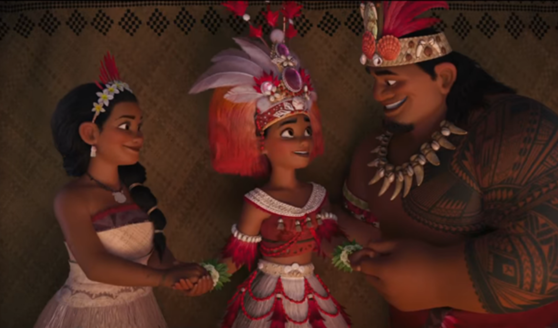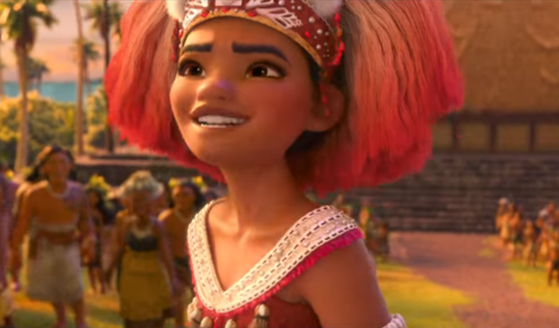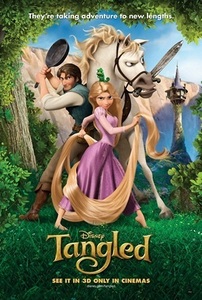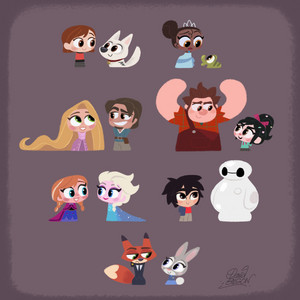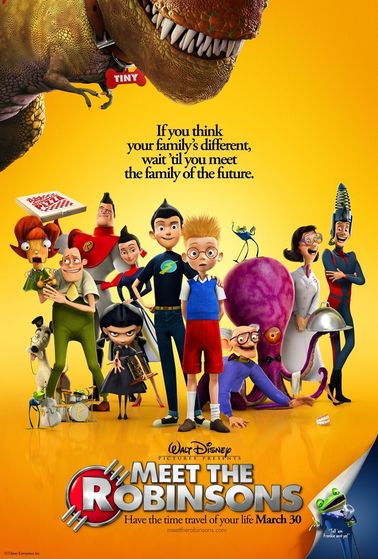It's probably not difficult to figure out the meaning behind the song "Where آپ Are," but آپ might be surprised سے طرف کی the careful planning that went into its lyrics. سے طرف کی exploring multiple perspectives, it foreshadows مزید than آپ might think. So let's dive in and see how this song works as the first musical number of the movie.
Tui: Moana
Make way, make way
Moana, it's time آپ knew
The village of Motunui is all آپ need
Right off the bat, Chief Tui is helping young Moana to see the value of their island, but "helping" might not be the right word. He is outright saying that the village is all she would need, i.e. there is no need to look elsewhere. Is he forcing this idea onto her? Let's come back to that سوال as we continue.
The dancers are practicing
They dance to an ancient song
Dancers: Who needs a new song? This old one's all we need
I guess it's lucky that the older dancers made this point. Tui is taking Moana around the village, and this first example of the village dancers hits ہوم the value of tradition. They find the idea of a new dance unnecessary when the old one is serving them perfectly well. Moana may still be very young at this point, but she could be starting to understand that there is value to the traditions they keep.
Tui: This tradition is our mission
And Moana, there's so much to do
Don't trip on the taro root
That's all آپ need
Well, now it's clear. Somewhat. What we know is that the goal is to maintain the customs of the village, which entails a lot of work, as the سیکنڈ line implies. This would explain Tui's concerned look he gives when he sees Moana's drawing, which shows her sailing on a canoe. A little later in the movie, we learn that the islanders haven't voyaged in a thousand years. They've gotten used to this life, so of course he would be concerned if Moana wanted to bring this back.
What we DON'T know is whether this "mission" is the goal of the entire island, یا just of the chieftains. I think Tui wants to stabilize the islanders' current lifestyles because he personally wants to prevent voyaging from returning. Since the chief must, of course, look after the safety and well-being of everyone on the island, one way to do so is to not take up anything that could be dangerous...like voyaging. But it's interesting that there would be "so much to do" if the island has already stayed put for so long. Maybe he means there is a lot to work on with Moana herself, to get the idea of exploring the sea out of her head.
As for the taro root, quick research online shows that it is a staple of Polynesian cooking. It looks like it's a simple nod to their culture.
We share everything we make (we make)
We joke and we weave our baskets (haha)
The fishermen come back from the sea
This stanza is much simpler. Tui is again دکھانا Moana some of the village's traditions, this time basket-making. But she is clearly مزید interested in the sea as she designs a کینو instead of a basket, and toddles to the ساحل as the fishermen return.
Moana: I wanna see
Tui: Don't walk away
Moana, stay on the ground now
Our people will need a chief and there آپ are
And here's our first direct instance of Moana's dad keeping her away from the sea since saving the baby turtle. Moana is basically told that she will someday be chief, and so her people will look up to her for guidance. The first half of this stanza now seems pretty clever. Tui saying "Don't walk away...stay on the ground now" implies "Moana, don't walk away from your responsibilities. Stay grounded." This doubles as a reminder to stay away from the ocean ("stay on the ground," not in the water). We know she has a great interest in the sea, but it's looked down upon if it means avoiding her future duties (aside from it being dangerous).
Tui & Sina: There comes a day
When you're going to look around
And realize happiness is where آپ are
Moana's parents are teaching her that one day, she'll learn to appreciate what she has -- that she will find happiness on the island. She is told this when she tries to sneak off in a canoe. The need to sneak off means she is aware that her parents, father especially, look down on it. At this point, she doesn't seem very fond of becoming chief, instead wanting to go out to sea.
Tui: Consider the coconut (the what?)
Consider its trees
We use each part of the coconut
That's all we need
We're back to seeing how the island continues to make use of what it has. The islanders are resourceful and use the coconut to its full extent, so they think there is no need for anything else.
Sina: We make our nets from the fibers
The water is sweet inside
We use the leaves to build fires
We cook up the meat inside
This is proof that they use each part of the coconut, illustrating their resourcefulness to Moana. It might also be دکھانا off these parts to their culture for the viewer's benefit. But a major takeaway is their reliance on this one object for all of these things. If the coconut trees go away, they will need to step out of the comfort zone and innovate. But we've seen what sticklers these guys are for tradition, so what are the odds of that happening?
Tui: Consider the coconut
The trunks and the leaves
The island gives us what we need
Here we just get a repeat of the coconut spiel as Moana's latest effort to escape to the ocean fails. سے طرف کی now they've made it clear that her passion to explore outranks all else.
Moana: And no one leaves
Tui: That's right, we stay
We're محفوظ and we're well-provided
And when we look to the future, there آپ are
Moana finally realizes that there's no getting off this island, and understandably looks a bit disappointed when she tries on the chief headdress. Her dad assures that the people are محفوظ سے طرف کی staying, and that Moana again will be looked up to for guidance. It's also getting across the importance of her staying. When the people need help, she'll be right there on the island to do so (i.e. not away at sea).
You'll be okay
In time, you'll learn just as I did
آپ must find happiness right where آپ are
So, Tui once looked elsewhere to find happiness too, but came to accept the island as the ذریعہ of that. It's a clue that he was drawn to the ocean like his daughter, as we learn later from the flashback. He anticipates that Moana will follow suit, but at this point in the song, she sees her grandma dancing سے طرف کی the water and runs to her. We can figure out pretty quickly that this is not that time.
Tala: I like to dance سے طرف کی the water
The undertow and the waves
The water is mischievous, ha!
I like how it misbehaves
Moana appears happy in this scene. Grandma Tala seems to be the one person on the island who understands her love for the sea, which explains why she's so close to her.
The village may think I'm crazy
یا say that I drift too far
But once آپ know what آپ like, well there آپ are
Here, Tala acknowledges how she is commonly perceived سے طرف کی the other villagers, but disregards it because she knows who she is. It's implied that Moana should not worry what others think of her love for the sea, simply saying that there's nothing wrong with having a fascination for it.
You are your father's daughter
Stubbornness and pride
Mind what he says, but remember
آپ may hear a voice inside
We have مزید evidence that Tala is trying to assure that Moana does not ditch her love for the sea just because she's expected to. She is encouraged to listen to her father of course, but also to keep an ear out for the "voice inside." This returns in "How Far I'll Go," with the line "But the voice inside sings a different song," indicating that she took her grandma's words to heart.
And if the voice starts to whisper
To follow the farthest star
Moana, that voice inside is who آپ are
And here still we have مزید evidence! Actually...maybe Tala IS trying to get her to leave after all. Pushing back the bushes to reveal the canoes is almost encouraging Moana to sail, isn't it? It's like she thinks voyaging defines Moana, and she hasn't been getting her fill.
Moana's father then walks in and Moana quickly covers up her intentions with "I was only looking at the boats. I wasn't going to get on them." Once again, we see her trying to not disappoint him. After, Tui walks her to the place of chiefs and explains that Moana will someday add a rock to the stack. He hits ہوم AGAIN that her people are not "out there" as he motions to the sea, but "right here." She now looks determined to assume the responsibilities of chief.
The اگلے stanza is a repeat of the uses of coconuts, but Moana is now getting in on the action سے طرف کی helping to collect them. Instead of being an outsider like she was as a kid, Moana is getting involved in these customs.
Tui: The village believes in us (that's right)
The village believes
The island gives us what we need
So, the village believes that the island gives everything they need to survive. They simply don't consider the possibility that resources could be found elsewhere. And it sounds like they have confidence in their leaders as well. So...what's going to happen when the island stops providing? And what's going to happen when the chieftains are unsure of what to do? Now آپ see where we're going with this. Sticking to tradition is far from a bad thing, but it will make it difficult for the villagers to adapt to change when the time comes. Moana's desire for voyaging, which is rather new for this particular generation of islanders, now seems like a good idea. But look where she is now:
Tui: And no one leaves
Moana: So here I'll stay
My home, my people beside me
And when I think of tomorrow, there we are
Moana now accepts her place on the island, no longer دکھانا an immediate desire to leave and explore. She assures herself that her people will always be closeby.
I'll lead the way
I'll have my people to guide me
We'll build our future together (there we are)
مزید of the same good stuff. Judging from her smiles in this scene, Moana is looking آگے to becoming chief and feels it is important that her people are there with her. Her parents look overjoyed at her change of heart.
'Cause every path leads آپ back to where آپ are
آپ can find happiness right where آپ are
Where آپ are
Where آپ are
Moana glimpses at her grandma, still dancing سے طرف کی the water, but shrugs it off, assured that she can find happiness on the island alongside her people. This scene mirrors the earlier scene where Moana first tried on the headdress and paraded with her parents. There, she ran off to شامل میں her grandma. But this time, she chooses not to.
Conclusion
So, maybe now you're seeing how many layers there are to this song. Here's what we have:
• Tui is preparing Moana for her future role as chief, and discourages her efforts to explore the ocean.
• The villagers believe that the island provides everything needed for survival, and are happy with maintaining tradition.
• Tala assures Moana at a young age that it's not bad to have a fascination of the ocean, and might even be encouraging her to sail despite what Tui wants.
• Moana originally preferred exploring over leading the island, but once she gets older, she is convinced to stay and looks happy to lead.
The song sneakily foreshadows that the village needs to change its lifestyle if they're going to survive. Not long after this scene, they find that مزید coconut trees are dying, and there are too few مچھلی in the reef. The young, rebellious Moana's desire to explore the sea now seems like a good idea to follow up on. It could mean access to مزید مچھلی and even another island, maybe one مزید hospitable than the one they have now. While "new Moana" hasn't forgotten her love for the sea, she is مزید reluctant to leave due to her father's wishes. Grandma Tala makes sure Moana still likes the sea, and may even be nudging her to sail. This could be to make sure that she fulfills her destiny, since she remembers the دن that the ocean chose her. Ultimately, Moana gives in, and her success shows how valuable change can be. سے طرف کی the end of the movie, she has solved Motunui's problem and opened the village up to voyaging, which they resume afterwards. Moana was the spark needed to facilitate much-needed change. For Tui and the rest of the village, this could be a sign to not immediately object to something that could solve a problem. Even if there are dangers, the success could make it worthwhile, hence why everyone must be open-minded and open to new ideas when thinking of a solution.
Thank آپ very much for reading this far! Feel free to leave your thoughts in the comments, and I'll see آپ around.
Tui: Moana
Make way, make way
Moana, it's time آپ knew
The village of Motunui is all آپ need
Right off the bat, Chief Tui is helping young Moana to see the value of their island, but "helping" might not be the right word. He is outright saying that the village is all she would need, i.e. there is no need to look elsewhere. Is he forcing this idea onto her? Let's come back to that سوال as we continue.
The dancers are practicing
They dance to an ancient song
Dancers: Who needs a new song? This old one's all we need
I guess it's lucky that the older dancers made this point. Tui is taking Moana around the village, and this first example of the village dancers hits ہوم the value of tradition. They find the idea of a new dance unnecessary when the old one is serving them perfectly well. Moana may still be very young at this point, but she could be starting to understand that there is value to the traditions they keep.
Tui: This tradition is our mission
And Moana, there's so much to do
Don't trip on the taro root
That's all آپ need
Well, now it's clear. Somewhat. What we know is that the goal is to maintain the customs of the village, which entails a lot of work, as the سیکنڈ line implies. This would explain Tui's concerned look he gives when he sees Moana's drawing, which shows her sailing on a canoe. A little later in the movie, we learn that the islanders haven't voyaged in a thousand years. They've gotten used to this life, so of course he would be concerned if Moana wanted to bring this back.
What we DON'T know is whether this "mission" is the goal of the entire island, یا just of the chieftains. I think Tui wants to stabilize the islanders' current lifestyles because he personally wants to prevent voyaging from returning. Since the chief must, of course, look after the safety and well-being of everyone on the island, one way to do so is to not take up anything that could be dangerous...like voyaging. But it's interesting that there would be "so much to do" if the island has already stayed put for so long. Maybe he means there is a lot to work on with Moana herself, to get the idea of exploring the sea out of her head.
As for the taro root, quick research online shows that it is a staple of Polynesian cooking. It looks like it's a simple nod to their culture.
We share everything we make (we make)
We joke and we weave our baskets (haha)
The fishermen come back from the sea
This stanza is much simpler. Tui is again دکھانا Moana some of the village's traditions, this time basket-making. But she is clearly مزید interested in the sea as she designs a کینو instead of a basket, and toddles to the ساحل as the fishermen return.
Moana: I wanna see
Tui: Don't walk away
Moana, stay on the ground now
Our people will need a chief and there آپ are
And here's our first direct instance of Moana's dad keeping her away from the sea since saving the baby turtle. Moana is basically told that she will someday be chief, and so her people will look up to her for guidance. The first half of this stanza now seems pretty clever. Tui saying "Don't walk away...stay on the ground now" implies "Moana, don't walk away from your responsibilities. Stay grounded." This doubles as a reminder to stay away from the ocean ("stay on the ground," not in the water). We know she has a great interest in the sea, but it's looked down upon if it means avoiding her future duties (aside from it being dangerous).
Tui & Sina: There comes a day
When you're going to look around
And realize happiness is where آپ are
Moana's parents are teaching her that one day, she'll learn to appreciate what she has -- that she will find happiness on the island. She is told this when she tries to sneak off in a canoe. The need to sneak off means she is aware that her parents, father especially, look down on it. At this point, she doesn't seem very fond of becoming chief, instead wanting to go out to sea.
Tui: Consider the coconut (the what?)
Consider its trees
We use each part of the coconut
That's all we need
We're back to seeing how the island continues to make use of what it has. The islanders are resourceful and use the coconut to its full extent, so they think there is no need for anything else.
Sina: We make our nets from the fibers
The water is sweet inside
We use the leaves to build fires
We cook up the meat inside
This is proof that they use each part of the coconut, illustrating their resourcefulness to Moana. It might also be دکھانا off these parts to their culture for the viewer's benefit. But a major takeaway is their reliance on this one object for all of these things. If the coconut trees go away, they will need to step out of the comfort zone and innovate. But we've seen what sticklers these guys are for tradition, so what are the odds of that happening?
Tui: Consider the coconut
The trunks and the leaves
The island gives us what we need
Here we just get a repeat of the coconut spiel as Moana's latest effort to escape to the ocean fails. سے طرف کی now they've made it clear that her passion to explore outranks all else.
Moana: And no one leaves
Tui: That's right, we stay
We're محفوظ and we're well-provided
And when we look to the future, there آپ are
Moana finally realizes that there's no getting off this island, and understandably looks a bit disappointed when she tries on the chief headdress. Her dad assures that the people are محفوظ سے طرف کی staying, and that Moana again will be looked up to for guidance. It's also getting across the importance of her staying. When the people need help, she'll be right there on the island to do so (i.e. not away at sea).
You'll be okay
In time, you'll learn just as I did
آپ must find happiness right where آپ are
So, Tui once looked elsewhere to find happiness too, but came to accept the island as the ذریعہ of that. It's a clue that he was drawn to the ocean like his daughter, as we learn later from the flashback. He anticipates that Moana will follow suit, but at this point in the song, she sees her grandma dancing سے طرف کی the water and runs to her. We can figure out pretty quickly that this is not that time.
Tala: I like to dance سے طرف کی the water
The undertow and the waves
The water is mischievous, ha!
I like how it misbehaves
Moana appears happy in this scene. Grandma Tala seems to be the one person on the island who understands her love for the sea, which explains why she's so close to her.
The village may think I'm crazy
یا say that I drift too far
But once آپ know what آپ like, well there آپ are
Here, Tala acknowledges how she is commonly perceived سے طرف کی the other villagers, but disregards it because she knows who she is. It's implied that Moana should not worry what others think of her love for the sea, simply saying that there's nothing wrong with having a fascination for it.
You are your father's daughter
Stubbornness and pride
Mind what he says, but remember
آپ may hear a voice inside
We have مزید evidence that Tala is trying to assure that Moana does not ditch her love for the sea just because she's expected to. She is encouraged to listen to her father of course, but also to keep an ear out for the "voice inside." This returns in "How Far I'll Go," with the line "But the voice inside sings a different song," indicating that she took her grandma's words to heart.
And if the voice starts to whisper
To follow the farthest star
Moana, that voice inside is who آپ are
And here still we have مزید evidence! Actually...maybe Tala IS trying to get her to leave after all. Pushing back the bushes to reveal the canoes is almost encouraging Moana to sail, isn't it? It's like she thinks voyaging defines Moana, and she hasn't been getting her fill.
Moana's father then walks in and Moana quickly covers up her intentions with "I was only looking at the boats. I wasn't going to get on them." Once again, we see her trying to not disappoint him. After, Tui walks her to the place of chiefs and explains that Moana will someday add a rock to the stack. He hits ہوم AGAIN that her people are not "out there" as he motions to the sea, but "right here." She now looks determined to assume the responsibilities of chief.
The اگلے stanza is a repeat of the uses of coconuts, but Moana is now getting in on the action سے طرف کی helping to collect them. Instead of being an outsider like she was as a kid, Moana is getting involved in these customs.
Tui: The village believes in us (that's right)
The village believes
The island gives us what we need
So, the village believes that the island gives everything they need to survive. They simply don't consider the possibility that resources could be found elsewhere. And it sounds like they have confidence in their leaders as well. So...what's going to happen when the island stops providing? And what's going to happen when the chieftains are unsure of what to do? Now آپ see where we're going with this. Sticking to tradition is far from a bad thing, but it will make it difficult for the villagers to adapt to change when the time comes. Moana's desire for voyaging, which is rather new for this particular generation of islanders, now seems like a good idea. But look where she is now:
Tui: And no one leaves
Moana: So here I'll stay
My home, my people beside me
And when I think of tomorrow, there we are
Moana now accepts her place on the island, no longer دکھانا an immediate desire to leave and explore. She assures herself that her people will always be closeby.
I'll lead the way
I'll have my people to guide me
We'll build our future together (there we are)
مزید of the same good stuff. Judging from her smiles in this scene, Moana is looking آگے to becoming chief and feels it is important that her people are there with her. Her parents look overjoyed at her change of heart.
'Cause every path leads آپ back to where آپ are
آپ can find happiness right where آپ are
Where آپ are
Where آپ are
Moana glimpses at her grandma, still dancing سے طرف کی the water, but shrugs it off, assured that she can find happiness on the island alongside her people. This scene mirrors the earlier scene where Moana first tried on the headdress and paraded with her parents. There, she ran off to شامل میں her grandma. But this time, she chooses not to.
Conclusion
So, maybe now you're seeing how many layers there are to this song. Here's what we have:
• Tui is preparing Moana for her future role as chief, and discourages her efforts to explore the ocean.
• The villagers believe that the island provides everything needed for survival, and are happy with maintaining tradition.
• Tala assures Moana at a young age that it's not bad to have a fascination of the ocean, and might even be encouraging her to sail despite what Tui wants.
• Moana originally preferred exploring over leading the island, but once she gets older, she is convinced to stay and looks happy to lead.
The song sneakily foreshadows that the village needs to change its lifestyle if they're going to survive. Not long after this scene, they find that مزید coconut trees are dying, and there are too few مچھلی in the reef. The young, rebellious Moana's desire to explore the sea now seems like a good idea to follow up on. It could mean access to مزید مچھلی and even another island, maybe one مزید hospitable than the one they have now. While "new Moana" hasn't forgotten her love for the sea, she is مزید reluctant to leave due to her father's wishes. Grandma Tala makes sure Moana still likes the sea, and may even be nudging her to sail. This could be to make sure that she fulfills her destiny, since she remembers the دن that the ocean chose her. Ultimately, Moana gives in, and her success shows how valuable change can be. سے طرف کی the end of the movie, she has solved Motunui's problem and opened the village up to voyaging, which they resume afterwards. Moana was the spark needed to facilitate much-needed change. For Tui and the rest of the village, this could be a sign to not immediately object to something that could solve a problem. Even if there are dangers, the success could make it worthwhile, hence why everyone must be open-minded and open to new ideas when thinking of a solution.
Thank آپ very much for reading this far! Feel free to leave your thoughts in the comments, and I'll see آپ around.

My current icon might be a clue...that I'm going to count the movies since TPatF.

2016 D23 Artwork


